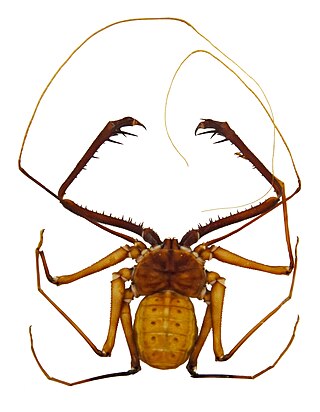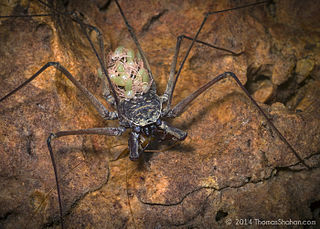
Amblypygi is an order of arachnids also known as whip spiders or tailless whip scorpions, not to be confused with whip scorpions or vinegaroons that belong to the related order Thelyphonida. The name "amblypygid" means "blunt tail", a reference to a lack of the flagellum that is otherwise seen in whip scorpions. Amblypygids possess no silk glands or venom. They rarely bite if threatened but can grab fingers with their pedipalps, resulting in thornlike puncture injuries.

Uropygi is an arachnid order comprising invertebrates commonly known as whip scorpions or vinegaroons. They are often called uropygids. The name "whip scorpion" refers to their resemblance to true scorpions and possession of a whiplike tail, and "vinegaroon" refers to their ability when attacked to discharge an offensive, vinegar-smelling liquid, which contains acetic acid. The order may also be called Thelyphonida. Both names, Uropygi and Thelyphonida, may be used either in a narrow sense for the order of whip scorpions, or in a broad sense which includes the order Schizomida.

Pedipalps are the secondary pair of forward appendages among chelicerates – a group of arthropods including spiders, scorpions, horseshoe crabs, and sea spiders. The pedipalps are lateral to the chelicerae ("jaws") and anterior to the first pair of walking legs.

Centruroides is a genus of scorpions of the family Buthidae. Several North American species are known by the common vernacular name bark scorpion. Numerous species are extensively found throughout the southern United States, Mexico, Central America, the Antilles and northern South America. Some are known for their interesting patterning or large size ; most if not all fluoresce strongly under ultraviolet illumination, except after moulting. They contain several highly venomous species, and fatalities are known to occur. The venom of the Mexican scorpion Centruroides limpidus limpidus contains the neurotoxins Cll1 and Cll2.

Tarantulas comprise a group of large and often hairy spiders of the family Theraphosidae. As of December 2023, 1,100 species have been identified, with 166 genera. The term "tarantula" is usually used to describe members of the family Theraphosidae, although many other members of the same infraorder (Mygalomorphae) are commonly referred to as "tarantulas" or "false tarantulas". Some of the more common species have become popular in the exotic pet trade. Many New World species kept as pets have setae known as urticating hairs that can cause irritation to the skin, and in extreme cases, cause damage to the eyes.

Phrynus marginemaculatus, simply known as spotted tailless whip scorpion is a species of amblypygid found in southern Florida, the Bahamas, Cuba, and Hispaniola. They are nocturnal predators that hide during the day in small retreats.

Mastigoproctus giganteus, the giant whip scorpion, also called the giant vinegaroon or grampus, is a species of whip scorpions in the family Thelyphonidae. Its native range is from the Southern United States to Mexico.

Damon medius is a species of arachnid of the family Phrynichidae.

Phrynus is a genus of whip spiders found in tropical and subtropical regions, mostly in the new world.

Phrynus longipes is a species of amblypygid native to the Caribbean region. They are protective of their territory, using their pedipalps to deter predators or unwanted visitors. Being nocturnal predators, they take shelter during the day and hunt primarily at night. Phrynus longipes feeds on primarily arthropods, but has been observed to prey upon small vertebrates.

Phrynidae is a family of amblypygid arachnida arthropods also known as whip spiders and tailless whip scorpions. Phrynidae species are found in tropical and subtropical regions in North and South America. Some species are subterranean; all are nocturnal. At least some species of Phrynidae hold territories that they defend from other individuals.

Acanthophrynus is a genus of tailless whipscorpion in the family Phrynidae containing a single species, Acanthophrynus coronatus. This species is sometimes kept as a pet.

Phrynus operculatus is a species of tailless whipscorpion in the family Phrynidae.
Phrynichus is a genus of tailless whipscorpions in the family Phrynichidae. There are about 16 described species in Phrynichus.

Heterophrynus is a genus of whip spiders, also known as tailless whip scorpions, of the family Phrynidae, in the monotypic subfamily Heterophryninae.

Paraphrynus carolynae is a species of tailless whip scorpion from Mexico and the southwestern United States.

Diplocentrus is a genus of toothed scorpions in the family Diplocentridae. There are more than 60 described species in Diplocentrus, found mainly in Central America, Mexico, and the southwest United States.

Weygoldtina is an extinct genus of tailless whip scorpion known from Carboniferous period, and the only known member of the family Weygoldtinidae. It is known from two species described from North America and England and originally described in the genus Graeophonus, which is now considered a nomen dubium.

Phrynus maesi is a species of amblypygid in the family Phrynidae. It is endemic to Nicaragua, specifically among the volcanic mountains in the department of Jinotega and in the Bosawás Biosphere Reserve.


















